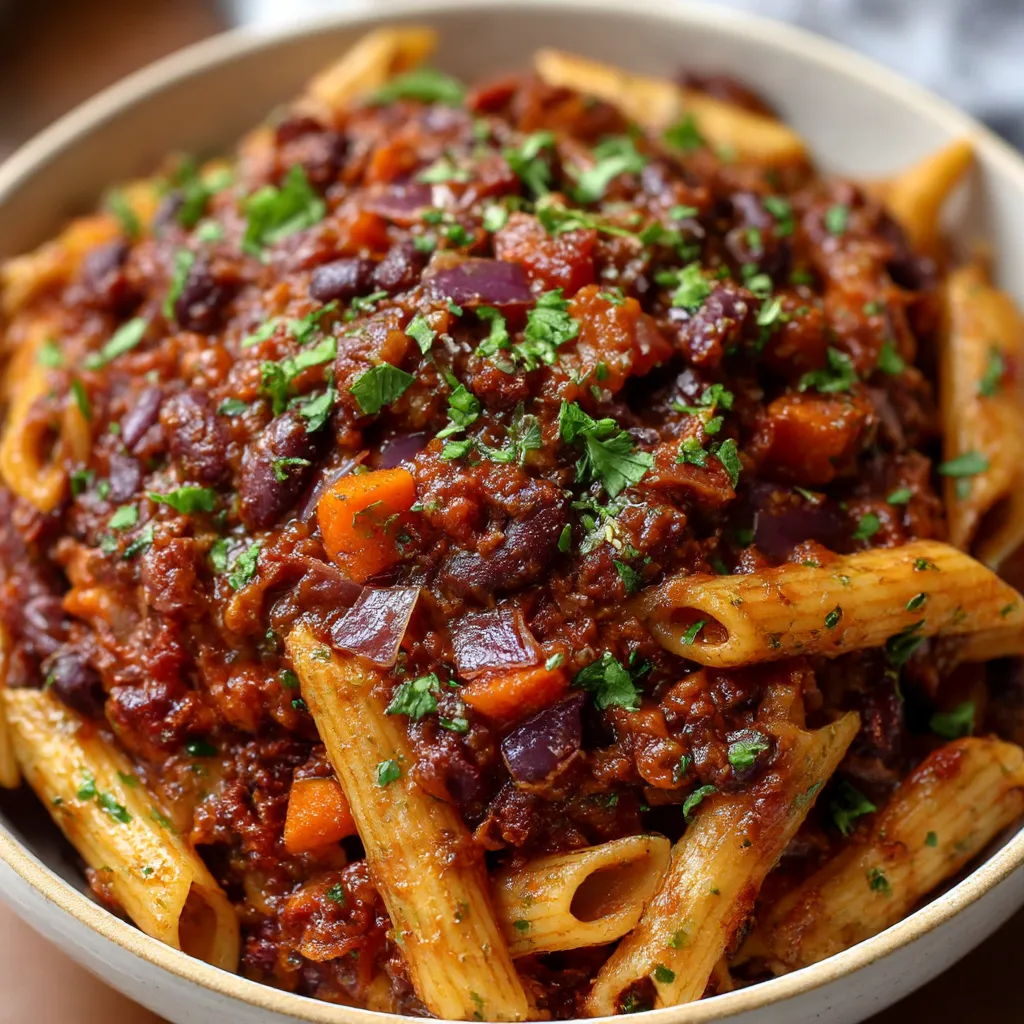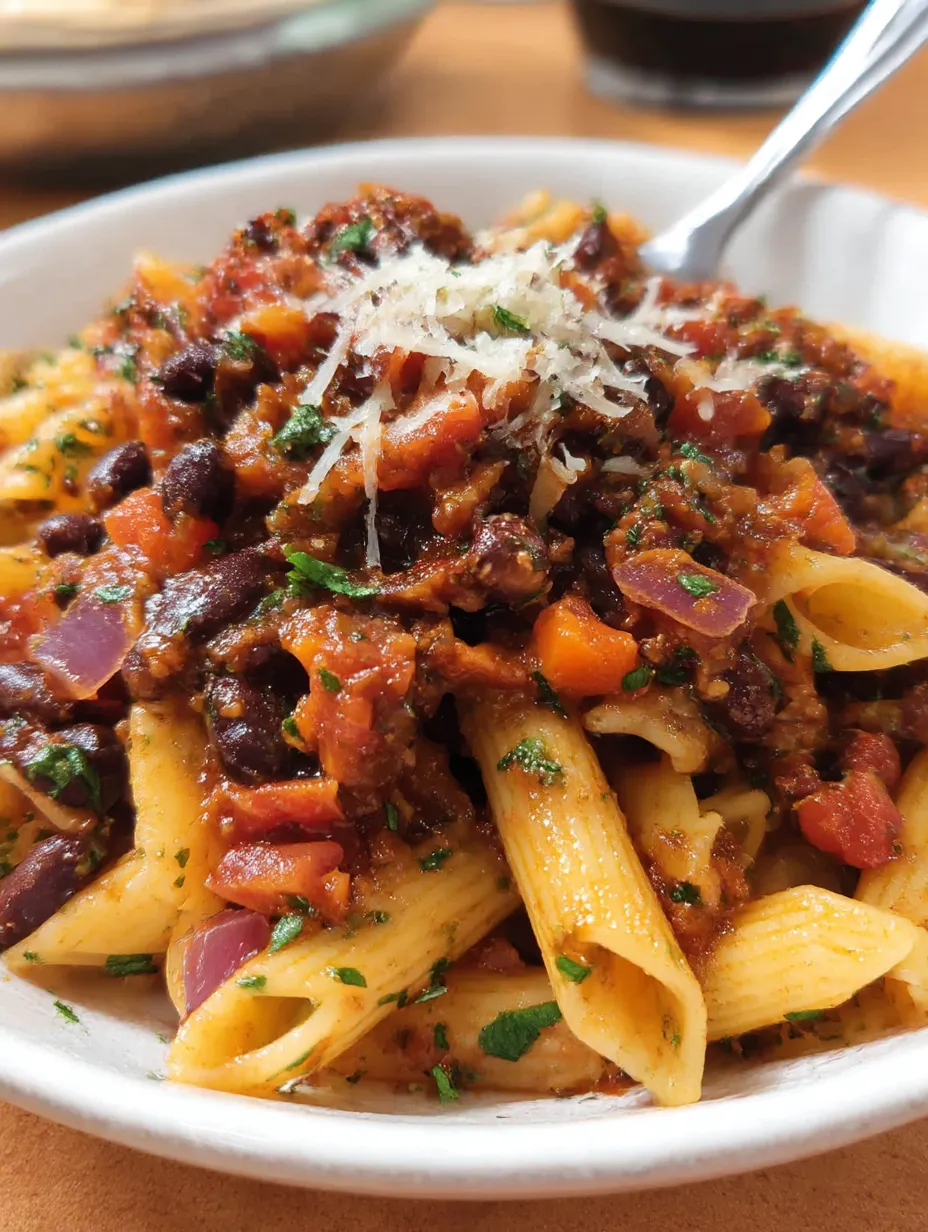 Pin it
Pin it
This rich black bean pasta sauce is a go-to dish when you want something hearty and deeply flavorful without relying on meat or dairy. Black beans simmer with plenty of aromatics, herbs, and a splash of red wine to transform humble pantry staples into a bold and satisfying topping for your favorite pasta. It is just the thing when you need dinner that feels special but is actually pretty simple to make.
I first put this sauce together when I was short on groceries and trying to make something comforting for a friend. Now it lives in my weeknight dinner rotation and we never get tired of it.
Ingredients
- Your favorite pasta: about 9 ounces look for shapes that hold sauce well like penne or fusilli
- Olive oil: helps soften vegetables and brings everything together choose extra virgin for best flavor
- Red onion: adds sweetness and color use a firm one with shiny skin
- Carrot: brings a subtle earthy sweetness and added nutrition
- Celery: offers savoriness and traditional Italian depth
- Garlic: for a pungent hit choose plump fresh cloves
- Dried oregano: a classic Italian herb that rounds out flavors use a fresh jar for full potency
- Red chili flakes: offer gentle heat start with less if sensitive to spice
- Fresh rosemary: gives incredible aroma use a fragrant sprig not dried
- Bay leaves: build savory depth and perfume the sauce
- Tomato paste: for concentrated umami pick one with no added sugar if possible
- Canned black beans: bring plant protein go for low-sodium and rinse well
- Canned diced tomatoes: form a rich sauce look for Italian or San Marzano style if available
- Red wine: deepens and enriches the taste choose a bold dry wine you’d actually drink
- Salt: sharpens flavors use sea salt if you have it
- Black pepper: gives gentle heat freshly cracked makes a difference
- Chopped fresh parsley: for garnish looks lovely and adds fresh taste pick bright green bunches
- Grated Parmesan or vegan parm: for finishing completely optional but helps bring all the flavors together
Step-by-Step Instructions
- Prep and Boil Pasta:
- Put a large pot of salted water on to boil while you work on the sauce. Cook your pasta as the package directs until just al dente. Drain and set aside.
- Cook the Vegetable Base:
- In a heavy pot or Dutch oven heat olive oil over medium and add your diced onion carrot and celery. Let them cook gently for five to seven minutes stirring now and then until they are very soft and aromatic. This slow cook makes the base of the sauce sweet and savory.
- Layer Aromatics and Herbs:
- Add garlic oregano chili flakes rosemary sprig and bay leaves. Let these cook for about a minute so everything gets extra fragrant. This quick bloom releases all the oils from the herbs and spices.
- Tomato Paste and Wine:
- Spoon in the tomato paste and stir to coat the vegetables. Pour in your red wine to deglaze and scrape up anything stuck to the pot bottom. Let this bubble for a minute or two so most of the alcohol burns off. The tomato and wine combo brings loads of depth.
- Add Beans and Tomatoes:
- Stir in the rinsed black beans and diced tomatoes plus salt and black pepper. Combine well and bring to a gentle simmer. Lower the heat cover and let it cook for about twenty minutes so the flavors blend and everything softens beautifully.
- Mash for Thickness:
- After simmering some of the beans will have softened. Use the back of a wooden spoon or a potato masher to gently press some beans into the side of the pot. This thickens the sauce making it creamy and luxurious.
- Finish and Serve:
- Remove the rosemary sprig and bay leaves. Taste and add extra salt or pepper if you think it needs more seasoning. Toss the cooked drained pasta with the sauce right in the pot so every bite is coated. Serve with fresh parsley and a sprinkle of grated cheese if you want.
 Pin it
Pin it
My favorite part of this recipe is the way the red wine and rosemary work together turning simple black beans into something that reminds me of slow-cooked Italian ragù. My kids love to help smash the beans and always try to sneak bites before we sit down at the table.
Storage Tips
Store any leftover sauce and pasta separately in airtight containers in the fridge. The sauce tastes even richer the next day and holds up well for up to four days. Gently reheat on the stove with a splash of water to loosen the sauce.
Ingredient Substitutions
If you do not have black beans you can swap in cannellini or kidney beans for a slightly different flavor. For the wine you can use vegetable broth if you prefer to skip alcohol. You can toss in other vegetables like diced zucchini or mushrooms if you want extra texture and nutrients.
Serving Suggestions
This sauce is fantastic over whole wheat penne or glutenfree pasta. It pairs nicely with a side of bitter greens like arugula salad. A thick slice of toasted country bread works for scooping up every last bit. If you have leftover sauce you can use it as a topping for baked potatoes or even as a warm dip for crusty bread.
A Little History
Pasta with legume-based sauces has a long tradition in Italian cooking especially in southern regions where beans are a staple. Using canned beans makes this version weeknight friendly while keeping the same rustic flavors of classic cucina povera meals.
Frequently Asked Questions
- → Can I use a different type of pasta?
Absolutely! Penne, fusilli, spaghetti, or even gluten-free varieties all pair well with the black bean sauce.
- → What does the red wine add to the sauce?
Red wine deepens the flavor, adding richness and complexity to the sauce. The alcohol cooks off, leaving only its savory notes.
- → Is smashing the beans necessary?
Yes, mashing some beans thickens the sauce naturally and creates a creamy texture that clings to the pasta.
- → How do I make this dish vegan?
Omit the cheese or use a plant-based alternative to keep the dish fully plant-based from start to finish.
- → Can I add extra vegetables?
Feel free to include diced zucchini, mushrooms, or bell peppers to add variety and boost nutrition in the sauce.
- → How do I store leftovers?
Store cooled sauce and pasta separately in airtight containers in the fridge for up to 3 days. Reheat gently before serving.
